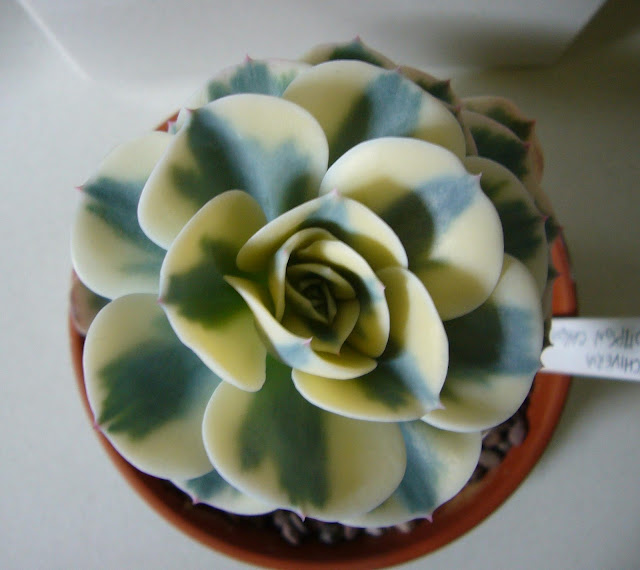 |
| My second plant in May 2013, the first suddenly decided to die. |
Right so you have searched and found your plant, you get it home and settle back to enjoy your prize only for it to suddenly up and die. You are devastated; apart from the money, you're back to trying to track one down again. You treated it the same as your other plants, it is an echeveria after all so shouldn't be that fussy. So what went wrong?
 |
| This years flowers, the best to date. |
Firstly and this is important. What works for me may not work for you. The most common mistake with this plant is to think as an echeveria it is simple and will cope with the usual succulent stuff. I find them to be sensitive to light, heat and water.
Light. Mine are grown in the the greenhouse in the UK, this means they do not get direct sunlight. I have not tried one outside but in full sun I would expect them to burn. The leaves are not strong at all and do not need an excuse to curl up and die. The same goes for low light, they are prone to get leggy.
Heat. They do not seem to cope with extreme heat and even in the UK on hot days in the green house they can go from nice plant to mess. It goes without saying that they do not cope with cold, I did leave one in the green house over this winter which went down to -3C. But that was totally dry from November - March.
Water. Where most people go wrong as they are really prone to rot and drying out. This is especially true as they settle into a new home or when taking offsets. I tend to give them half the amount of water other plants get, whenever I move them. Initially you want the soil to be damp not wet and never get water in the crown. If it is hot, keep a eye on the water as they will need to be watered, as hot and too dry will cause you problems as well. Once settled and growing you can go back to a more normal water regime, but still avoid water in the crown.
Linked to all of this is the soil mix. It must be free draining as you do not want plants sitting in any water. It also needs to have some food; they are weak plants and need all the help they can get. I use blood, fish and bone in the mix and feed them one a month from May - July.
It is vital to work out what is required for your location, it will vary, but watch your plants and they will tell you what is working. Once you work that out, they are easy:
 |
| My collection of plants May 2016, all from that one original plant |
Firstly they throw out quite a few white pups. As amazing as they are, treat them like flowers. Admire while there are around and know they will die. I have managed to get one through two seasons, most last only one. Except that and you will enjoy them and save yourself a lot of heartbreak.
There are a few tricks you can use to get offsets. Feed you plants as mentioned before, a strong plant will offset nicely. If things are not happening quick enough, forcing the plant in lower light. The elongated stem will produce lots of pup.
If you leave the leaves on you will find you get offsets like the one on the left in the photo above. If you take the leaves off you will get good offsets on the trunk as can be seen as well. Remember this plant is weak, so some transplanted offsets will not root. Do not treat them like you do for other offsets. A lot less water to start with, then intensive care monitoring the watering building it up little by little over a month.
To be honest I tend to do the reverse of my normal and propagate by top cutting, that way you get lots of plants in the original pot and as can be seen form the photos. The stems on the main plant form roots and stand more chance to re-root, this seems far more successful than trying to remove pups.
Top cutting a plant once it has roots visible, will give a nice new plant. Remember take the watering slow to start with and keep it in the shade. The plants that remain in the original pot will grow quickly to fill the space and give you a pot full of plants by the end of that season. These will eventually get leggy, offset, and send out their own roots and the process can start again.
 |
| Flower stalk with variegated laves as well. |
I would like to say I never loose plants, but of course I do. Especially when trying to root offsets. Accept it and keep note of what works and what doesn't. People who have followed for a while, know I like my experiments and recording my results. For this plant I physically write down when I water and feed offsets and the outcome.
Finally settle back and enjoy them and the looks of envy you get from any other succulent lovers who see your plants still alive. Just don't tell anyone your secrets!
I hope this helps, please feel free to leave comments, either without or without your name. Let me know if I have missed anything and what works for you.













































